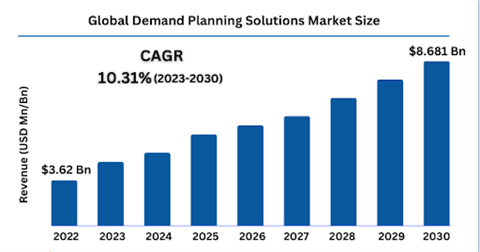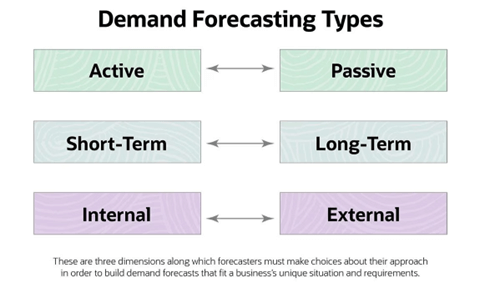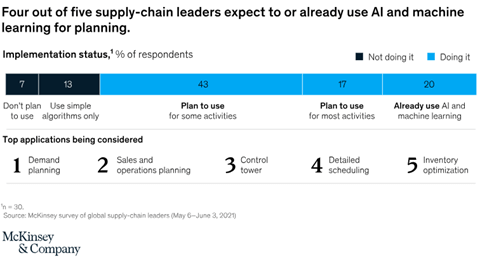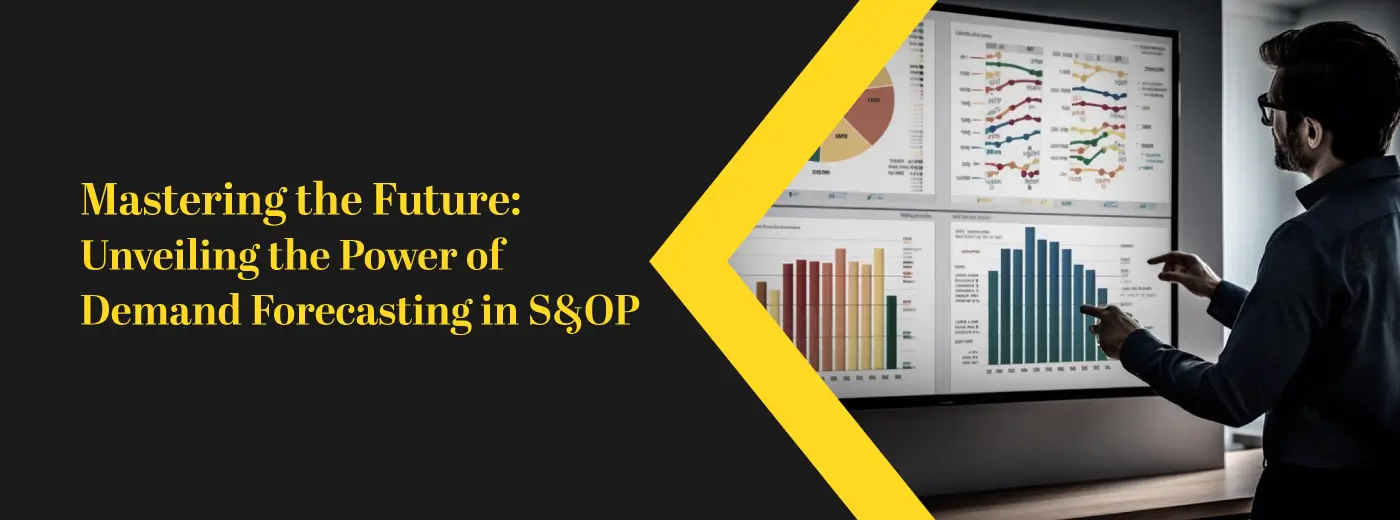Editor's Note: In today's rapidly evolving business landscape, where adaptability is paramount, one indispensable tool stands out as a guiding beacon—Demand Forecasting. In this blog, we embark on a journey to illuminate the transformative potential of this critical business practice within Sales and Operations Planning (S&OP). Explore the possibilities and benefits of this essential practice, as it continues to shape the future of strategic decision-making in the corporate world.
Introduction Demand Forecasting Components in S&OP
In the intricate world of modern business, where uncertainty is the only constant and success hinges upon accurate decision-making, one indispensable tool emerges as a guiding beacon—Demand Forecasting.
Picture this: a world where businesses anticipate consumer desires with uncanny accuracy, optimize resources flawlessly, and orchestrate their operations like a symphony. This is not a far-fetched dream but a reality attainable through the strategic integration of Demand Forecasting within Sales and Operations Planning (S&OP).
In this digital age, where information flows like a river and markets evolve at the speed of thought, the ability to predict future demand has transformed from a competitive advantage to a critical necessity.
It is the linchpin upon which strategic decisions are made, production is aligned, and customer satisfaction is realized. To truly grasp the significance of Demand Forecasting in S&OP, let's embark on a journey illuminated by compelling examples that underscore its transformative potential.
Apple's visionary approach to S&OP hinged on its unparalleled understanding of customer behavior and data-driven insights.
Before the iPhone's launch, Apple's supply chain wizards worked their magic, utilizing historical sales data, market trends, and psychological factors to predict demand meticulously. This foresight wasn't mere prophecy but Demand Forecasting—a strategic amalgamation of science and intuition.

The impact was staggering. As demand forecasts were meticulously translated into production plans, Apple managed to avoid the pitfalls of supply shortages or excess inventory.
With precise demand projections, Apple orchestrated an exquisitely timed release, creating an aura of exclusivity and driving customers to line up for the iconic device eagerly. The iPhone's unprecedented success was, in no small part, due to the impeccable synergy between Demand Forecasting and S&OP.
Today, we embarked on a voyage to delve into the captivating realm of demand forecasting. Dive in!
Demand and Supply - The connection
Picture a vibrant marketplace teeming with enthusiastic customers searching for their desired products. Within this complicated connection, businesses strive to achieve the perfect harmony between fulfilling customer needs and maintaining operational efficiency. This is precisely where demand forecasting comes into play, acting as a guiding beacon amidst the complex interplay of sales and operations.
The rise of demand forecasting and its crucial role in demand planning is on the horizon. In fact, as per Zion Market Research, the global demand planning market is poised to reach a valuation of USD 8.681 Billion by 2030, exhibiting an impressive compound annual growth rate (CAGR) of approximately 10.31% from 2023 to 2030. These figures are truly remarkable, considering that the market was valued at USD 3.62 Billion in 2022.

Different Strands of Demand Forecasting

| Active Active demand forecasting adopts an ambitious growth-oriented strategy, consisting of marketing initiatives, economic projections, product development endeavors, market expansion predictions, and other relevant elements. This methodology leverages in-depth market research, surveys, meticulous historical data analysis, and insightful consumer input analysis to predict emerging trends and consumer behaviors. |
Passive The passive approach includes observing the collection of data from different sources and abstaining from deliberate data pursuit. Utilizing the potential of big data and intuitive comprehension, this approach empowers enterprises to unveil invaluable insights and pre-empt forthcoming demand without explicit searching for it. |
Short-Term Termed as "short-term" forecasting, this type pertains to predictions spanning around 3 to 12-month window. It proves valuable for organizations grappling with abrupt supply chain issues, enabling swift remediation. Additionally, it facilitates seamless adaptation to evolving consumer preferences. |
Long-Term Long-term demand forecasting extends over 1 to 4 years compared to its short-term counterpart. Engineered to chart the course of business expansion, this type of forecasting draws upon sales data and detailed market research. It doesn't shy away from an aspirational approach, aiming for ambitious milestones and envisioning a triumph-filled future. |
Internal (Micro Level) Internal demand forecasting encapsulates predicting upcoming service or product demand within an enterprise's framework. This business forecasting variant lays bare potential impediments that could impede companies progress, illuminating unexplored avenues for advancement and growth. |
External (Macro Level) The domain of external demand forecasting encompasses a sweeping panorama of the economy. It dissects how prevailing trends and ongoing operations will influence broader business objectives. A macro-level external demand forecast factors in the availability of raw materials and the complex interplay of elements impacting various facets of the supply chain. |
Inputs Required to Manage Demand Forecasting
Demand forecasting is a crucial process that helps businesses estimate the future demand for their products or services. The inputs for demand forecasting are derived from various sources; let's explore each of these sources:
Customers Data:
Customers play a significant role in providing input for demand forecasting, especially in the manufacturing industry. Businesses collect customer data through various means, such as surveys, feedback forms, customer service interactions, and online reviews. These data points offer valuable insights into customer preferences, buying behavior, and changing needs.
Manufacturing companies often analyze historical sales data to identify patterns and trends in customer demand. By studying past sales and customer orders, they can determine seasonality, cyclical patterns, and other factors influencing demand fluctuations. Customer demand data also helps identify slow-moving or fast-moving products, allowing businesses to optimize inventory management and production planning.
Marketing Activities:
In industries where trends change rapidly and volatility is high, marketing plays a crucial role in shaping demand forecasting. Marketing teams use various strategies to create awareness and promote products or services to potential customers. Their efforts generate demand signals that can be utilized for forecasting future sales.
Marketing campaigns, social media trends, and consumer behavior analysis provide valuable data for demand forecasting. By monitoring the response to marketing initiatives, businesses can gauge customer interest and anticipate shifts in demand. Moreover, marketing teams analyze data from competitor analysis, market research, and industry reports to gain insights into market dynamics, which are essential for accurate forecasts.
Sales Team:
The sales team acts as a direct link between the business and its customers. They interact with customers regularly, which puts them in an ideal position to gather real-time demand information. The sales team collects data on customer inquiries, purchase orders, and sales leads, which can be used to estimate the demand in the short term and the long time.
Sales representatives at different organizational levels contribute valuable insights from their territories or markets. Sales managers and regional sales heads consolidate and communicate the demand-related data they receive to the central demand forecasting team. This hierarchy helps obtain a comprehensive picture of demand across different segments and regions.
Therefore, demand forecasting relies on customer input, marketing efforts, and the sales team to ensure accurate predictions. By leveraging these inputs, companies can make informed decisions on production planning, inventory management, and resource allocation to meet demand fluctuations effectively and optimize their operations.
Research and Development (R&D):
Research and Development (R&D) holds a pivotal but indirect role in the realm of demand forecasting, particularly for businesses operating in industries fueled by innovation. R&D's influence on this process manifests in several key aspects.
Firstly, as companies delve into R&D initiatives to create or enhance products, they significantly impact demand forecasting by necessitating clear communication of development timelines. This allows the forecasting team to anticipate product readiness for the market.
Additionally, R&D often uncovers production constraints, informing forecasting decisions regarding timing and scale. R&D teams also gauge market readiness for innovations, aiding in the precise estimation of initial demand. Innovations resulting from R&D can disrupt markets and must be considered in forecasting.
Lastly, R&D may affect lead times, influencing inventory management and, consequently, demand forecasts. In summary, R&D's insights and outputs are integral to the demand forecasting process, requiring effective collaboration to align product development efforts with market demand, especially in innovation-driven industries.
Forecasting's Symphony: Sales and Operations Planning (S&OP)
As a crucial component, demand planning in the S&OP process has a cross-functional business process aimed at aligning sales, marketing, production, and other relevant departments to balance demand and supply effectively. The integration between demand forecasting and S&OP involves the following steps:
1. Demand Forecasting Input:
Demand forecasting provides the initial estimates of future demand based on inputs from customers, marketing, and the sales team. These estimates help create a demand plan, outlining the expected quantities of products or services customers will likely purchase over a specific time horizon.
2. S&OP Planning Meetings:
S&OP demand planning typically involves regular meetings where representatives from different departments come together to review and discuss the demand forecast. This collaborative approach ensures that various stakeholders are aligned and can make informed decisions based on a holistic understanding of demand and supply dynamics.
3. Demand Review:
During S&OP meetings, the demand forecast is reviewed and validated. This involves comparing the forecasted demand with historical sales data, market trends, and other relevant factors. The goal is to identify any discrepancies or anomalies that may require adjustments to the forecast.
4. Supply Planning:
Once the demand forecast has been reviewed and validated, it serves as a foundational input for supply planning. Supply planning involves assessing the organization's capacity, production capabilities, and inventory levels. Businesses can determine whether they are adequately prepared to meet customer requirements by comparing the forecasted demand with the available supply.
5. Balancing Demand and Supply:
Integrating demand forecasting and S&OP allows businesses to balance customer demand with supply capabilities. Suppose the demand forecast indicates a significant increase in demand for a particular product. In that case, the S&OP process enables proactive measures to ensure sufficient production capacity, materials, and resources are allocated to meet the expected demand.
6. Scenario Planning:
Another crucial aspect of integrating demand forecasting with S&OP is scenario planning. Businesses can simulate various scenarios, such as changes in demand patterns, supply disruptions, or market fluctuations, to assess their potential impact on overall operations. This enables risk mitigation strategies and proactive decision-making.
7. Alignment and Collaboration:
S&OP fosters collaboration and alignment among departments, such as sales, marketing, production, and finance. By integrating demand forecasting into this process, organizations ensure that everyone understands the demand outlook and can work together to develop strategies that maximize operational efficiency and customer satisfaction.
8. Reconciliation and Adjustments:
As part of the S&OP process, adjustments may be made to the demand forecast based on input from various stakeholders. For example, if the sales team identifies new opportunities or challenges, these insights can be incorporated into the demand plan. This iterative process ensures that the demand forecast remains dynamic and responsive to changing market conditions.
Henceforth, integrating demand planning in the S&OP process ensures businesses have a comprehensive and collaborative approach to managing demand and supply. This alignment enables organizations to optimize their operations, enhance customer satisfaction, and effectively navigate the complexities of today's dynamic business environment.
What does the future hold?
Demand forecasting is pivotal, guiding crucial decisions across production, procurement, and resource allocation. When armed with a united vision and dependable demand predictions, enterprises can optimize operations, alleviate bottlenecks, and elevate overall performance.
The significance of demand forecasting becomes evident when considering that businesses effectively integrating it into their Sales and Operations Planning (S&OP) processes achieve a remarkable 15% - 20% increase in perfect order fulfillment rates, surpassing those that disregard this practice (source: McKinsey).

The data underscore a future for AI and intelligent insights that shines brighter than the sun. Consequently, it becomes logical and imperative for companies to join the bandwagon, seizing the competitive advantage and gaining unparalleled market insights.
The Key Takeaways
Effective demand forecasting necessitates a robust platform like Plan IQ, which empowers companies to respond swiftly, recalibrate promptly, and incorporate diverse scenarios as required. This ensures that enhanced forecast accuracy leads to optimal business results. Employing forecasting analytics facilitates strategic choices and equips leaders with the foresight and clarity necessary to navigate uncertainty, enabling them to position their businesses for accelerated progress in the upcoming phase.
Polestar Solutions collaborates with Anaplan, enabling supply chain, finance, sales, and human resources teams to make exact decisions through forecasting analytics. Reach out to our team of Anaplan specialists to learn more.



